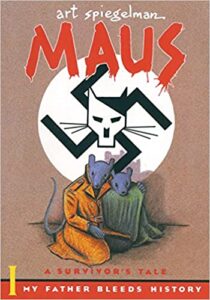Maus I: A Survivor’s Tale: My Father Bleeds History
Art Spiegelman
Pantheon Books
Published November 1, 1991 (Originally published in 1986)
Amazon | Bookshop | Goodreads
About Maus I: A Survivor’s Tale: My Father Bleeds History
The first installment of the Pulitzer Prize-winning graphic novel acclaimed as “the most affecting and successful narrative ever done about the Holocaust” (Wall Street Journal) and “the first masterpiece in comic book history” (The New Yorker).
A brutally moving work of art—widely hailed as the greatest graphic novel ever written—Maus recounts the chilling experiences of the author’s father during the Holocaust, with Jews drawn as wide-eyed mice and Nazis as menacing cats.
Maus is a haunting tale within a tale, weaving the author’s account of his tortured relationship with his aging father into an astonishing retelling of one of history’s most unspeakable tragedies. It is an unforgettable story of survival and a disarming look at the legacy of trauma.
My Review – Content Warning for Mentions of Suicide and Genocide
I remember a friend of mine reading this book in late elementary school. Our teacher commented on it and what an amazing book it was. Many of us hadn’t read it, so she had him explain what it was about.
But it wasn’t until this year, after a Tennessee school board banned the book for use in eighth grade curriculum that I decided it was long past time for me to read it. Honestly, I should have read this book long before now, and it makes me want to go back and read NIGHT by Elie Wiesel and his other books.
Maus, Banned from Eighth Grade Curriculum
First, I want to speak to the book ban. The school board banned the book from use in eighth grade curriculum because they said it contained profanity, nudity, and suicide. I’m not sure from the article that I read whether the curriculum used both books or just one of the two volumes. This review is focused on volume one, which tells the story of Vladek Spiegelman’s life in the late 1930s and early 1940s until he and his wife were captured and sent to Auschwitz.
In the first volume, I counted two swear words. There was one frame that showed a vague drawing of the top of a woman’s head and part of her torso as she’s lying in a tub, dead. We understand a dark shape on the floor to be blood. In other frames, Artie learns that his mother has committed suicide, and also that he deeply struggles with her death– as anyone would.
Before that section of the book, we know that Artie’s mom has died from suicide, so I felt that softened the blow that those pages and the stark emotions conveyed through Artie’s expressions, though they’re still heartbreaking.
There are some other very brief disturbing frames described in the content section below.
Why I Read MAUS
One of the things about MAUS that really stands out to me, though, is that it recounts survivors stories without only telling of their survival during the war. It also shows what Vladek’s life is like as an older man and a widower. It shows what Artie, as the child and sibling of WWII and Holocaust survivors, faces and feels and believes.
As students study the Holocaust, I can’t help but believe that learning not just numbers and facts, but real stories of lives impacted is a critical part of education. The first volume of MAUS relates what Vladek and his wife and others endured as prisoners of war, members of a Jewish Ghetto, workers in a forced labor camp, and families in hiding.
I love that we read about and learn about heroes who risked their lives to hide Jewish families during World War II. Those are great stories to read. But if we don’t also read narratives told by and about the survivors themselves, we don’t address the inhumanity and cruelty of the Holocaust.
There is no way to understand what happened to the millions of people who endured or were murdered in concentration camps like Auschwitz without encountering horror. If the ugly, brutal, unconscionable parts of history don’t make us uncomfortable, God help us.
A text like MAUS introduces those truths to readers does in tiny snapshot moments. This gives lots of time for parents and educators to answer questions and offer support as kids digest this history.
At any rate, I’m glad I read MAUS I. I am already reading the second volume and will post a detailed review as I finish it.
Content Notes
Content warning for violence against children, mentions and very brief depiction of execution. References to genocide. Mentions of suicide and also a brief depiction of suicide.
Recommended for Ages 14 up.
Representation
Major characters in the story are Jewish. Artie’s parents survived the Holocaust at Auschwitz.
Profanity/Crude Language Content
Brief strong profanity used infrequently. (I counted two swear words as I read.)
Romance/Sexual Content
One page shows Artie and his wife asleep in bed together before a phone call wakes them up. Vague hint that Artie’s dad was sleeping with a girlfriend he had before he met Artie’s mom. No graphic details.
Spiritual Content
Artie’s dad talks about how he used to pray and was very religious.
Violent Content
Some brief but shocking descriptions of violence. One frame shows soldiers holding the legs of children next to a wall with holes in it. The narrative says Vladek heard that soldiers killed children this way when they wouldn’t stop crying. In one section, Vladek tells of a group of civilians who were marched away. He heard gunshots later, indicating that soldiers murdered the civilians.
One frame shows someone looking up at the feet of people who spoke against the government and were hanged. The narrative explains that this happened.
Artie’s dad talks about things that people did to avoid being captured and sent to Auschwitz. One panel shows a woman, Artie’s aunt, calling three children to her. The narrative states she kept poison on her at all times and poisoned herself and the three children rather than let the soldiers capture them.
In one chapter, Artie’s dad has discovered a comic that he wrote about his mother’s suicide. One panel shows his father finding his mother’s body. The comic focuses on his guilt and grief and how difficult it was to watch his father’s grief as well. It’s raw, and relates grief in a very up-close and personal way.
Artie’s dad mentions rumors they heard about Auschwitz, but before he saw it himself, he hoped the rumors were exaggerated.
Drug Content
Artie and his father smoke cigarettes together.
Note: This post contains affiliate links, which do not cost you anything to use, but which help support this blog.
Maus: A Survivor’s Tale: why I read the graphic novel banned in some disctricts and why it’s important. My review and content notes here.


















Thank you for your honesty, and I agree with the need to learn more than just numbers and facts!
I love your posts – they are super helpful for me as a mom to decide which books to let my youngest daughter read as a 12YO. She’s a voracious reader – hard to keep up with, so I’m always looking for suggestions!
Thanks, Eileen. I feel you– twelve can be a tough age to find great books for! A lot of YA seems geared toward older readers and at twelve, a lot of readers are transitioning out of middle grade books. I’ve been meaning to put a list together of books I recommend for twelve to fourteen year old readers. This reminds me that I really need to do that. If your daughter likes graphic novels, she might enjoy the Lightfall series by Tim Probert. If she’s interested in fantasy, I recommend Julie Mathison’s Old Rus series. For contemporary, maybe check out Kasie West’s books? Here’s a list of books I reviewed that I flagged as for readers 10-14: https://thestorysanctuary.com/?s=Recommended+for+Ages+10+to+14.